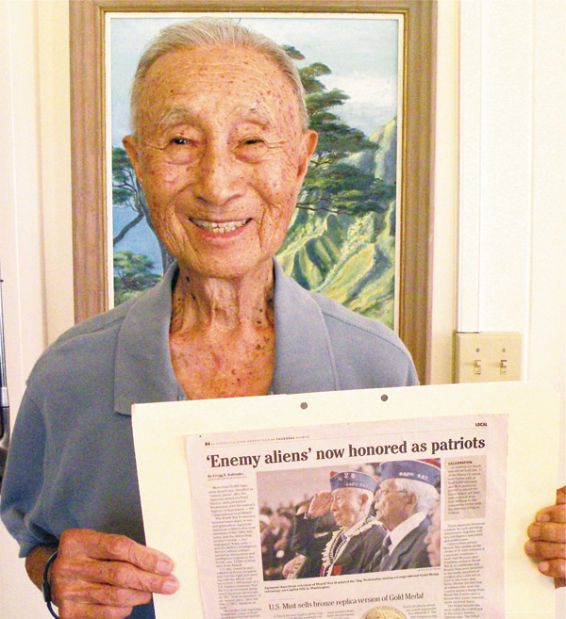Kauai is home to many veterans who have served our country in United States military actions, all of whom deserve our gratitude. World War II veterans Turk Tokita, 93; Kazuma Monty Nishiie, 98; Jiro Yukimura, 92; and Norman Hashisaka, 88;
Kauai is home to many veterans who have served our country in United States military actions, all of whom deserve our gratitude. World War II veterans Turk Tokita, 93; Kazuma Monty Nishiie, 98; Jiro Yukimura, 92; and Norman Hashisaka, 88; were kind enough to share their personal stories in my book, “Kauai Stories.”
Hashisaka and Yukimura served in the Military Intelligence Service, translating documents captured from Japanese soldiers. Nishiie and Tokita fought for the United States in Europe against Japan, the country of their parents’ birth, Nishiie earning a Purple Heart and Tokita earning two Purple Hearts for injuries sustained during war.
Anti-Japanese sentiment ran high in the United States during the war, even against American-born Japanese fighting for America, but Japanese Americans were determined to prove their loyalty.
Here is an abbreviated version of Tokita’s story in his own words:
When I was 21, I volunteered to be drafted into the U.S. Army and was stationed at Schofield Barracks on Oahu as a supply clerk. After about six months of work, in 1943, I was given a seven-day pass for time off. I flew home to Kauai.
On my fifth day on Kauai, I thought, “I better go back.” I went to get a seat assignment the next morning wearing my U.S. Army uniform and waited all day. They wouldn’t put me on the plane, but they let Caucasians on. They told me, “We don’t have any room. Come back tomorrow morning.”
The next morning, I waited and waited and they wouldn’t put me on. They looked me right in the face and said, “We don’t have room for you.”
I called my Captain and he said, “I can’t do anything for you. You get here by tomorrow morning 6 o’clock or you’re going to be AWOL.”
On Monday morning at 10 a.m. they finally let me get on the plane. When I reported to Schofield Barracks, the captain told me, “We’re going to charge you with being Absent Without Official Leave and you’re going to be court-martialed.”
Just before I went out of his office, I looked up and saw this big sign on the wall asking for cadres (personnel) for a newly forming unit of the 442nd combat team made up of all Japanese ancestry. I asked, “What if I volunteer for that outfit?” The captain said, “If you’re out of here today, pack yourself and move, we’ll drop all charges.”
I rushed back to the barracks, packed my things and boom! I was out of there. I’m happy that happened because I got into the 442nd.
During training, our members of the 442nd always said, “Let’s go for broke. Let’s throw everything in, nevermind we die or not.” We knew we weren’t going to come back.
Tokita earned the first of his two Purple Hearts in 1944 outside a small village in France.
I was wounded in the back. One piece of shrapnel about four inches long stopped about one inch before my spine. Fortunately it didn’t come through to my chest or I would be dead.
The next day I woke up in a field hospital with about 150 of our boys in various stages of dying. It was maybe the following day when they finally took me in. I was on the operating table and they said, “We ran out of anesthetic. Is it all right to operate on you?” I said, “Go ahead.” They put something in my mouth to bite on. All I remember is the first cut.
I wish they had sent me home. But they wouldn’t allow us to have anybody else but Japanese Americans for replacements. And we just didn’t have enough boys.
Three weeks after Tokita’s injury, the wound in his back still bleeding, he was sent back to the front lines. Not long after that, he was wounded again, earning his second Purple Heart. After returning home from the war, Tokita attended art school in Chicago. While there, he encountered complete disregard for Hawaii by medical professionals, including a doctor at the Department of Veterans Affairs. That convinced him that Hawaii, then a territory of the United States, must become a state.
After my experiences with the doctor and dentist in Chicago, I was convinced that Hawaii had to become a state. I figured it was the only way we were ever going to get anything.
I went to Honolulu where I met Dan Inouye (also a 442nd member), Patsy Mink and others who were campaigning for John A. Burns to become a delegate to Congress. Burns got elected for the first time in 1956. In 1959, he got us statehood.
Burns became Hawaii’s second governor and was our governor for 12 years. I was his Kauai campaign manager for all of his terms. I was Kauai campaign manager for three more Hawaii governors after Burns.
Before the war, I was an introvert. Because of politics, I became an extrovert. My life really changed. I helped with statehood and became involved in all kinds of things for a better life for everybody.
The 100th/442nd Regimental Combat Team, in which Tokita and Nishiie fought, became the most highly decorated units in U.S. military history.
In 2011, 66 years after the war ended, members of the 100th, 442nd, and the Military Intelligence Service were recognized in a Congressional Medal of Honor ceremony in Washington, D.C., finally acknowledged as the Americans they had always been.
• If you have a story you would like to share for Brown’s forthcoming new book, “Kauai Stories II,” contact: pam@kauaistories.net; 651-3533. Visit www.kauaistories.net


